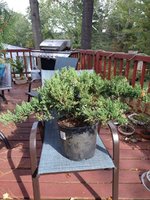Last August, I repotted some nursery mugos that we similarly root bound. I literally sawed off the bottom half of the roots. 5 out of 6 are looking fine. I was too aggressive with pruning the branches on the one that did not survive.
Do you think that sawing off half off half the root ball on a juniper would also work?
There are many issues at work every time we repot, not just root reduction but conditions in the weeks following, health of the plant before, species, etc.
I 1would not hesitate to remove half roots of the junipers I grow - shimpaku and J, procumbens 'Nana'. Some species may not be so tolerant. Conditions at your place may be different after repot so hard to be definitive.
Certainly removing too much foliage can affect recovery after root pruning especially for pines and junipers as you've found with the mughos. I've learned that leaving some intact growing leaders helps plants recover after root pruning and removing too much can reduce survival so now I do reduce branches but make sure some entire branches are left to encourage new roots and recovery.
Always check where lateral roots start growing on the trunk. I've been caught where trees have been potted at the bottom of the larger pot, new roots grow up and fill the soil so it appears there are good roots but sawing off the lower half end up with roots in one hand and trunk with no roots in the other hand. Always dig down to check for good lateral roots before deciding where to saw through the root mass.


